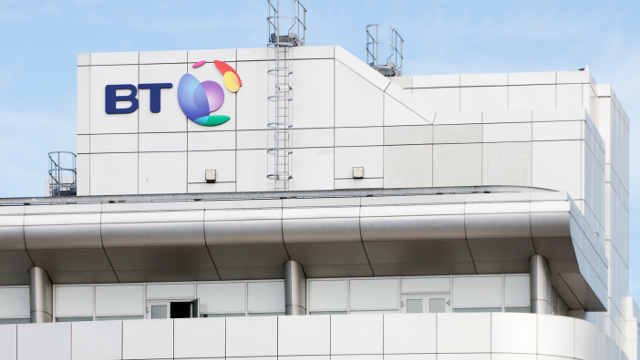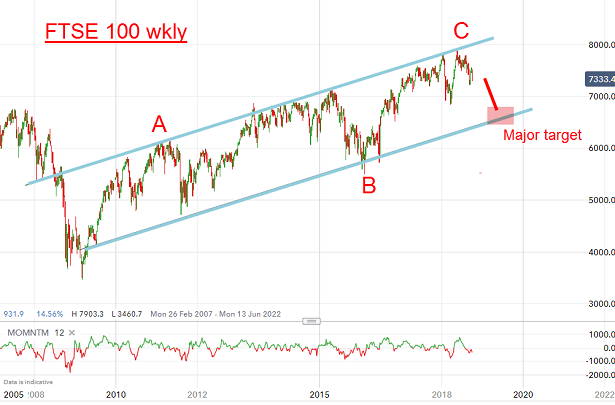Are BT shares a safe haven if FTSE 100 collapses?
8th October 2018 11:43
by John Burford from interactive investor
Share on
Both the FTSE 100 and BT are 'skating on thin ice', writes technical analyst John Burford, but he's spotted an area of huge value for the latter.

BT – a safe haven?
Last time, I showed how the formerly high-flying social media giants are falling off their perches, and last week, the Teflon-like major indexes – the Dow, the Nasdaq and the S&P – finally succumbed to the growing negative forces sweeping the financial sector.
So, is it time to be rotating into more defensive issues? Today I will look at the role BT could play in this exercise.
But first, I have a few thoughts on our own FTSE 100, which likewise seems to be skating on thin ice. Here is the big picture chart of action since the 2009 Credit Crunch low.

Source: interactive investor Past performance is nit a guide to future performance
Just a cursory glance shows the rally has been a fitful affair with highly overlapping waves. This is not the mark of a solid bull market – far from it.
The other point is that at the May high at 7,900, it only managed a pathetic gain of less than 5% over the 2000 high! Compare that with the S&P where the equivalent gain was over 90%. No wonder investors have been flocking to the US.
But with billions pumped into the UK economy by the ban of England (QE operations), the FTSE's performance has been less than stellar. So, the question arises: in the next downturn, will investor disappointment produce a tsunami of selling?
If that is indeed the case, then my first major target is on my lower tramline in the 6,700 area with lower potential thereafter.
So, can BT weather the storm?

Source: interactive investor Past performance is nit a guide to future performance
This is the action off the 2009 low and is a classic five-up with deep correction (to the Fibonacci 62% support) and on a momentum divergence (see red bar on lower chart).
We have seen these set-ups many times before! And most of them resolve to the upside (of course, there are exceptions since no forecast can be 100% secure).
But in any major general sell-off, the shares could move lower to the next Fibonacci level around £1.70, but that would represent huge value.
And this set-up is in the 'Buy low/Sell high' category, which is the investor's primary mantra (or at least should be). And the current dividend of over 6% is surely a deterrent for large-scale dumping.
John owns shares in BT
John Burford is the author of the definitive text on his trading method, Tramline Trading. He is also a freelance contributor and not a direct employee of interactive investor.
These articles are provided for information purposes only. Occasionally, an opinion about whether to buy or sell a specific investment may be provided by third parties. The content is not intended to be a personal recommendation to buy or sell any financial instrument or product, or to adopt any investment strategy as it is not provided based on an assessment of your investing knowledge and experience, your financial situation or your investment objectives. The value of your investments, and the income derived from them, may go down as well as up. You may not get back all the money that you invest. The investments referred to in this article may not be suitable for all investors, and if in doubt, an investor should seek advice from a qualified investment adviser.
Full performance can be found on the company or index summary page on the interactive investor website. Simply click on the company's or index name highlighted in the article.
Disclosure
We use a combination of fundamental and technical analysis in forming our view as to the valuation and prospects of an investment. Where relevant we have set out those particular matters we think are important in the above article, but further detail can be found here.
Please note that our article on this investment should not be considered to be a regular publication.
Details of all recommendations issued by ii during the previous 12-month period can be found here.
ii adheres to a strict code of conduct. Contributors may hold shares or have other interests in companies included in these portfolios, which could create a conflict of interests. Contributors intending to write about any financial instruments in which they have an interest are required to disclose such interest to ii and in the article itself. ii will at all times consider whether such interest impairs the objectivity of the recommendation.
In addition, individuals involved in the production of investment articles are subject to a personal account dealing restriction, which prevents them from placing a transaction in the specified instrument(s) for a period before and for five working days after such publication. This is to avoid personal interests conflicting with the interests of the recipients of those investment articles.